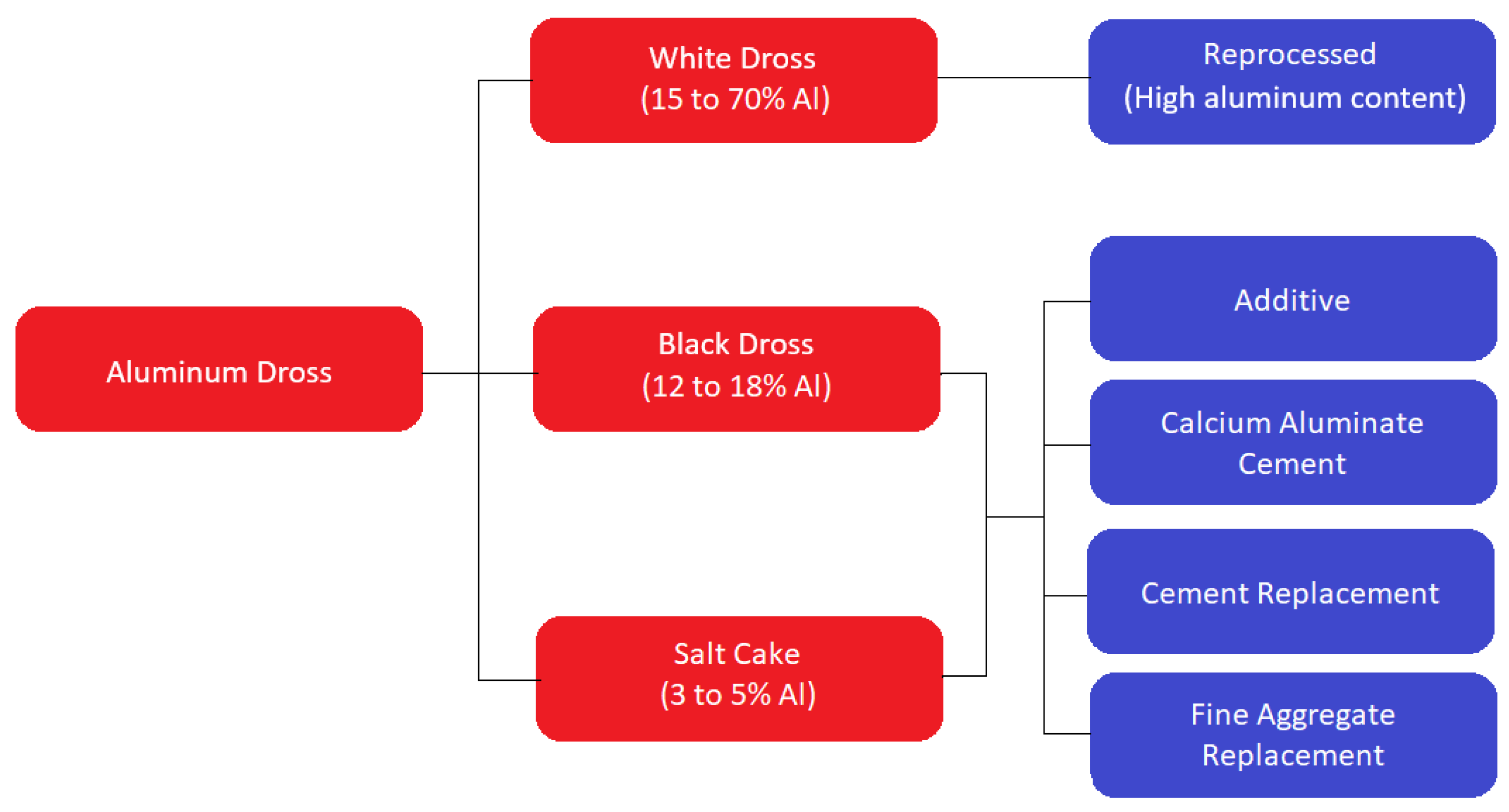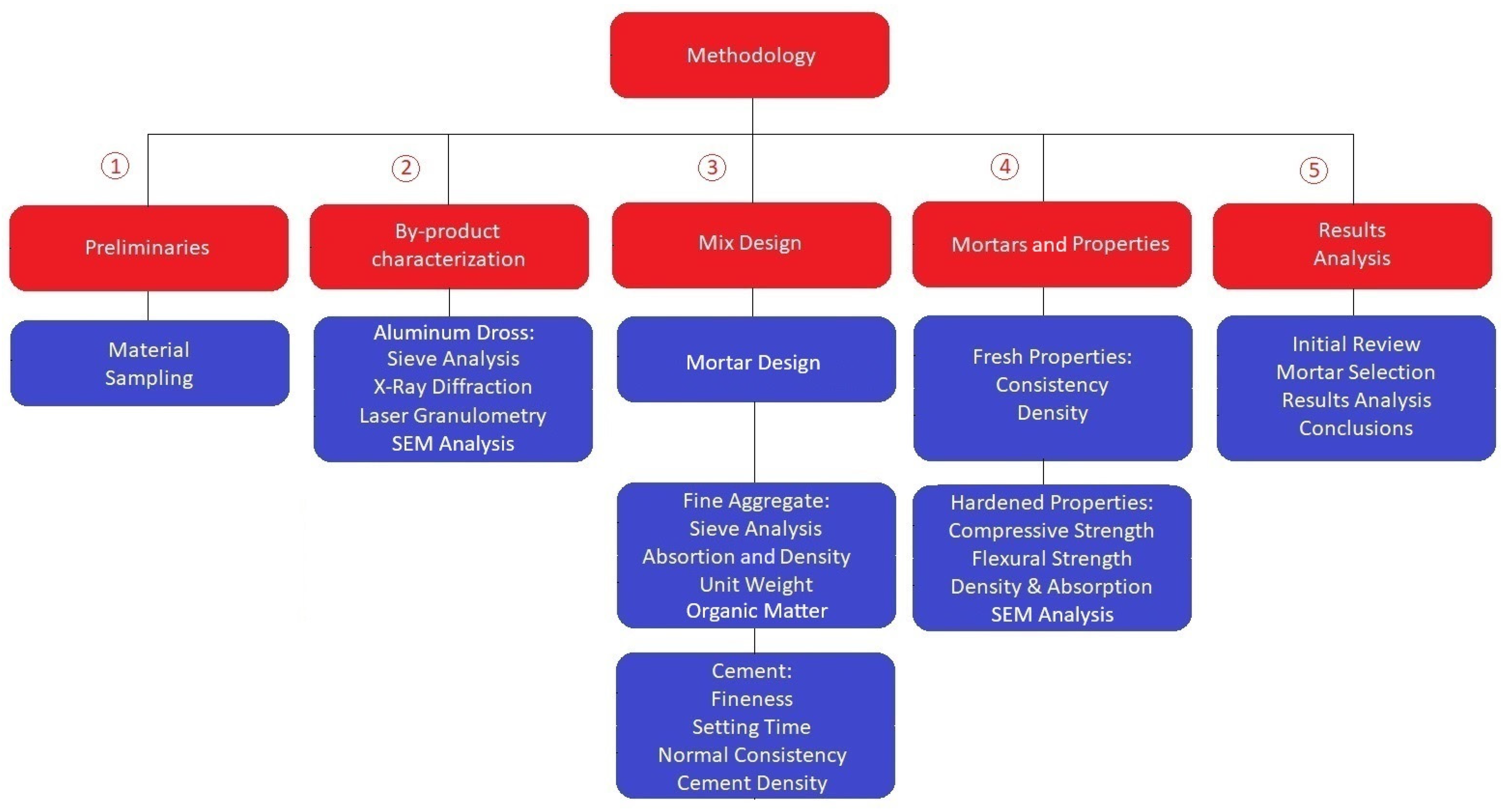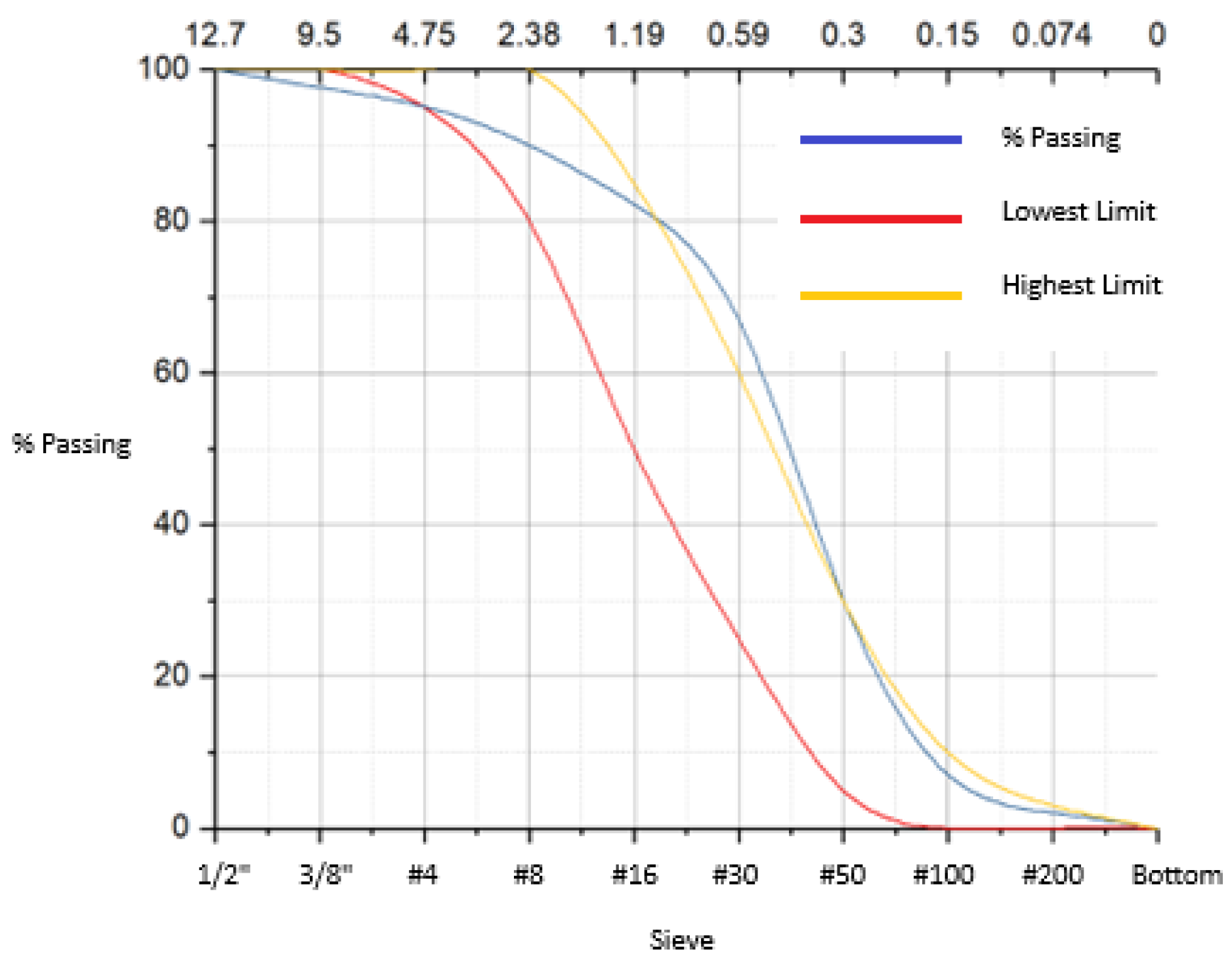Mechanical Performance of Mortars with Partial Replacement of Cement by Aluminum Dross: Inactivation and Particle Size
Abstract
:1. Introduction
2. Materials and Methods
3. Results Analysis
3.1. Preliminary Activities
3.2. By-Product Characterization
3.2.1. Aluminum Dross Inactivation
3.2.2. Aluminum Dross Grinding
3.3. Mix Design
3.4. Fresh and Hardened Properties of Mortars
4. Conclusions
Author Contributions
Funding
Institutional Review Board Statement
Informed Consent Statement
Data Availability Statement
Acknowledgments
Conflicts of Interest
Appendix A
| NTC Standard | ASTM Standard |
|---|---|
| NTC–77 Método de ensayo para el análisis por tamizado de los agregados finos y gruesos | ASTM C136/C136M-19 Standard Test Method for Sieve Analysis of Fine and Coarse Aggregates |
| NTC–237 Método de ensayo para determinar la densidad relativa (gravedad especifica) y la absorción del agregado fino | ASTM C128-22 Standard Test Method for Relative Density (Specific Gravity) and Absorption of Fine Aggregate |
| NTC–176 Método de ensayo para determinar la densidad relativa (gravedad específica) y la absorción del agregado grueso | ASTM C127-15 Standard Test Method for Relative Density (Specific Gravity) and Absorption of Coarse Aggregate |
| NTC–92 Método de ensayo para la determinación de la densidad volumétrica (masa unitaria) y vacíos en agregados | ASTM C29/C29M-17a Standard Test Method for Bulk Density (“Unit Weight”) and Voids in Aggregate |
| NTC–33 Método de ensayo para determinar la finura del cemento hidráulico por medio del aparato Blaine de permeabilidad al aire | ASTM C204-23 Standard Test Methods for Fineness of Hydraulic Cement by Air-Permeability Apparatus |
| NTC–118 Método de ensayo para determinar el tiempo de fraguado del cemento hidráulico mediante aguja de Vicat | ASTM C191-21 Standard Test Methods for Time of Setting of Hydraulic Cement by Vicat Needle |
| NTC–110 Cantidad de agua requerida para la consistencia normal de una pasta de cemento hidráulico | ASTM C187-23 Standard Test Method for Amount of Water Required for Normal Consistency of Hydraulic Cement Paste |
| NTC–221 Método de ensayo para determinar la densidad del cemento hidráulico | ASTM C188-17 Standard Test Method for Density of Hydraulic Cement |
| NTC–5784 Método de ensayo para determinar la fluidez de morteros de cemento hidráulico | ASTM C1437-20 Standard Test Method for Flow of Hydraulic Cement Mortar |
| NTC–1926 Método de ensayo para determinar la densidad (masa unitaria), el rendimiento y el contenido de aire por gravimetría del concreto | ASTM C138/C138M-23 Standard Test Method for Density (Unit Weight), Yield, and Air Content (Gravimetric) of Concrete |
| NTC–220 Determinación de la resistencia de morteros de cemento hidráulico a la compresión, usando cubos de 50 mm o 2 pulgadas de lado | ASTM C109/C109M-21 Standard Test Method for Compressive Strength of Hydraulic Cement Mortars (Using 2-in. or [50 mm] Cube Specimens) |
| NTC–120 Método de ensayo para determinar la resistencia a la flexión de morteros de cemento hidráulico | ASTM C348-21 Standard Test Method for Flexural Strength of Hydraulic-Cement Mortars |
| NTC–2017 Adoquines de concreto para pavimento | ASTM C1319-23 Standard Specification for Concrete Grid Paving Units |
Appendix B
| Abbreviation | Average | SD | CV | Max | Min | Range |
|---|---|---|---|---|---|---|
| C3S | 53.91 | 1.07 | 1.98 | 56.65 | 52.25 | 4.40 |
| C2S | 14.44 | 0.86 | 5.96 | 16.39 | 12.95 | 3.45 |
| C4AF | 11.83 | 0.21 | 1.77 | 12.25 | 11.42 | 0.83 |
| C3A | 4.85 | 0.29 | 6.06 | 5.54 | 4.39 | 1.15 |
| SiO2 | 20.85 | 0.32 | 1.56 | 21.55 | 20.33 | 1.22 |
| Al2O3 | 4.68 | 0.12 | 2.57 | 4.94 | 4.44 | 0.50 |
| Fe2O3 | 4.26 | 0.02 | 0.41 | 4.29 | 4.23 | 0.07 |
| CaO | 61.77 | 0.47 | 0.75 | 62.72 | 60.71 | 2.00 |
| MgO | 1.38 | 0.03 | 2.23 | 1.43 | 1.33 | 0.11 |
| Na2O | 0.12 | 0.00 | 3.40 | 0.13 | 0.12 | 0.02 |
| K2O | 0.20 | 0.02 | 10.61 | 0.24 | 0.16 | 0.08 |
| SO3 | 2.93 | 0.13 | 4.43 | 3.23 | 2.66 | 0.56 |
| Free lime | 0.97 | 0.18 | 18.65 | 1.49 | 0.67 | 0.82 |
| Alkaline equivalent | 0.26 | 0.02 | 6.39 | 0.29 | 0.23 | 0.07 |
References
- Maury-Ramírez, A.; Illera-Perozo, D.; Mesa, J.A. Circular Economy in the Construction Sector: A Case Study of Santiago de Cali (Colombia). Sustainability 2022, 14, 1923. [Google Scholar] [CrossRef]
- Villagrán-Zaccardi, Y.; Pareja, R.; Rojas, L.; Irassar, E.; Torres-Acosta, A.; Tobón, J.; Vanderley, J. Overview of cement and concrete production in Latin America and the Caribbean with a focus on the goals of reaching carbon neutrality. RILEM Tech. Lett. 2022, 7, 30. [Google Scholar] [CrossRef]
- Economía Circular—DANE. Available online: http://www.andi.com.co/Uploads/economia-circular-1-reporte.pdf (accessed on 6 April 2023).
- Maury-Ramírez, A.; De Belie, N. Environmental and Economic Assessment of Eco-Concrete for Residential Buildings: A Case Study of Santiago de Cali (Colombia). Sustainability 2023, 15, 12032. [Google Scholar] [CrossRef]
- Lemos-Micolta, E.D.; Chilito-Bolaños, L.C.; Maya-Soto, J.C.; Gómez-Gómez, A.; Rojas-Manzano, M.A. Uso de la Escoria de Aluminio en el Concreto–Revision del Estado del Arte. In Proceedings of the IX Congreso Internacional y 23a Reunión Técnica (AATH 2020), La Plata, Argentina, 2–6 November 2020. [Google Scholar]
- Pereira, D.A.; de Aguiar, B.; Castro, F.; Almeida, M.F.; Labrincha, J.A. Mechanical behaviour of Portland cement mortars with incorporation of Al-containing salt slags. Cem. Concr. Res. 2000, 30, 1131–1138. [Google Scholar] [CrossRef]
- Elinwa, A.U.; Mbadike, E. The use of aluminium waste for concrete production. J. Asian Architect. Build Eng. 2011, 10, 217–220. [Google Scholar] [CrossRef]
- Reddy, M.S.; Neeraja, D. Mechanical and durability aspects of concrete incorporating secondary aluminium slag. Resour. Effic. Technol. 2016, 2, 225–232. [Google Scholar] [CrossRef]
- Mailar, G.; Raghavendra, N.S.; Sreedhara, B.M.; Manu, D.S.; Hiremath, P.; Jayakesh, K. Investigation of concrete produced using recycled aluminium dross for hot weather concreting conditions. Resour. Effic. Technol. 2016, 2, 68–80. [Google Scholar] [CrossRef]
- Panditharadhya, B.J.; Sampath, V.; Mulangi, R.H.; Shankar, A.U.R. Mechanical properties of pavement quality concrete with secondary aluminium dross as partial replacement for ordinary portland cement. IOP Conf. Ser. Mater. Sci. Eng. 2018, 431, 032011. [Google Scholar] [CrossRef]
- Dai, C.; Apelian, D. Fabrication and characterization of aluminum dross-containing mortar composites: Upcycling of a waste product. J. Sustain. Metall. 2017, 3, 230–238. [Google Scholar] [CrossRef]
- Parra-Molina, D. Estudio del Comportamiento Mecánico de Morteros con Sustitución Parcial de Cemento por Escoria de Aluminio y Efecto de la Reducción del Tamaño de Partícula. Master’s Thesis, Universidad Javeriana Cali, Santiago de Cali, Colombia, 23 June 2023. [Google Scholar]
- Sánchez De Guzmán, D. Tecnología del Concreto y del Mortero; Bhandar Editores: Bogotá, Colombia, 2001. [Google Scholar]
- NTC–77; Método de Ensayo para el Análisis por Tamizado de los Agregados Finos y Gruesos. ICONTEC: Bogotá, Colombia, 2018.
- NTC–237; Método de Ensayo para Determinar la Densidad Relativa (Gravedad Especifica) y la Absorción del Agregado Fino. ICONTEC: Bogotá, Colombia, 2020.
- NTC–176; Método de Ensayo para Determinar la Densidad Relativa (Gravedad Específica) y la Absorción del Agregado Grueso. ICONTEC: Bogotá, Colombia, 2019.
- NTC–92; Método de Ensayo para la Determinación de la Densidad Volumétrica (Masa Unitaria) y Vacíos en Agregados. ICONTEC: Bogotá, Colombia, 1995.
- NTC–33; Método de Ensayo para Determinar la Finura del Cemento Hidráulico por Medio del Aparato Blaine de Permeabilidad al Aire. ICONTEC: Bogotá, Colombia, 2019.
- NTC–118; Método de Ensayo para Determinar el Tiempo de Fraguado del Cemento Hidráulico Mediante Aguja de Vicat. ICONTEC: Bogotá, Colombia, 2020.
- NTC–110; Cantidad de Agua Requerida para la Consistencia Normal de una Pasta de Cemento Hidráulico. ICONTEC: Bogotá, Colombia, 2019.
- NTC–221; Método de Ensayo para Determinar la Densidad del Cemento Hidráulico. ICONTEC: Bogotá, Colombia, 2019.
- NTC–5784; Método de Ensayo para Determinar la Fluidez de Morteros de Cemento Hidráulico. ICONTEC: Bogotá, Colombia, 2021.
- NTC–1926; Método de Ensayo para Determinar la Densidad (Masa Unitaria), el Rendimiento y el Contenido de Aire por Gravimetría del Concreto. ICONTEC: Bogotá, Colombia, 2013.
- NTC–220; Determinación de la Resistencia de Morteros de Cemento Hidráulico a la Compresión, Usando Cubos de 50 mm o 2 Pulgadas de Lado. ICONTEC: Bogotá, Colombia, 2021.
- NTC–120; Método de Ensayo para Determinar la Resistencia a la Flexión de Morteros de Cemento Hidráulico. ICONTEC: Bogotá, Colombia, 2022.
- NTC–2017; Adoquines de Concreto para Pavimento. ICONTEC: Bogotá, Colombia, 2018.
- Orozco-Erazo, D.A.; Vega-Báez, J.A. Estudio del Efecto del Tamaño de Partícula de Escoria de Aluminio Calcinada Utilizada como Reemplazo Parcial del Cemento en las Propiedades Mecánicas de Morteros. Bachelor’s Thesis, Pontificia Universidad Javeriana Cali, Santiago de Cali, Colombia, September 2022. [Google Scholar]
- Shinzato, M.C.; Hypolito, R. Solid waste from aluminum recycling process: Characterization and reuse of its economically valuable constituents. Waste Manag. 2005, 25, 37–46. [Google Scholar] [CrossRef] [PubMed]
- Bravo-German, A.M.; Bravo-Gómez, I.D.; Mesa, J.A.; Maury-Ramírez, A. Mechanical Properties of Concrete Using Recycled Aggregates Obtained from Old Paving Stones. Sustainability 2021, 13, 3044. [Google Scholar] [CrossRef]
- Ritchie, H.; Roser, M.; Rosado, P. CO2 and Greenhouse Gas Emissions. Our World in Data. 2023. Available online: https://ourworldindata.org/grapher/annual-co2-cement?tab=map (accessed on 15 September 2023).
- Global Consensus on Sustainability in the Built Environment—GLOBE. Decarbonising Global Construction. Available online: https://www.rilem.net/globe (accessed on 20 September 2023).
- Muñoz-Velez, M.F.; Salazar-Serna, K.; Escobar-Torres, D.; Rojas-Manzano, M.A.; Gómez-Gómez, A.; Maury-Ramírez, A. Circular Economy: Adding value to the post-industrial waste through the transformation of aluminum dross for cement-matrix applications. Sustainability 2023, 15, 13952. [Google Scholar] [CrossRef]













| Reference | Material with Aluminum By-Products as Cement Phase | Compressive Strength | Flexural Strength | Consistency Indicated by the Setting Time |
|---|---|---|---|---|
| [6] | Mortar with 10% aluminum salt cake | N.A. | ||
| [7] | Concrete with 10 to 15% aluminum dross | |||
| [8] | Concrete with 15% aluminum dross | N.A. | ||
| [9] | Concrete with 20% aluminum dross | |||
| [10] | Concrete with 5%, 10%, 15% and 20% aluminum dross |
| Mix Designation | Aluminum Dross Content (%) | Aluminum Dross Particle Size (µm) |
|---|---|---|
| REF | 0 | 0 |
| 5F | 5 | Fine (≤75 µm) |
| 5I | 5 | Intermediate (75–150 µm) |
| 5C | 5 | Coarse (150–300 µm) |
| 10F | 10 | Fine (≤75 µm) |
| 10I | 10 | Intermediate (75–150 µm) |
| 10C | 10 | Coarse (150–300 µm) |
| 20F | 20 | Fine (≤75 µm) |
| 20I | 20 | Intermediate (75–150 µm) |
| 20C | 20 | Coarse (150–300 µm) |
| Dross Condition | Specific Surface (m2/g) | Uniformity Coefficient | Average Particle Diameter (µm) |
|---|---|---|---|
| Washed dross | 0.121 | 1.03 | 243.105 |
| Dross without washing | 0.316 | 1.71 | 92.432 |
| Coarse dross (washed) | 0.329 | 0.48 | 234.895 |
| Intermediate dross (washed) | 0.500 | 0.624 | 80.022 |
| Fine dross (washed) | 0.829 | 0.809 | 22.912 |
| Parameter | Value |
|---|---|
| Sand density a | 2.68 g/cm3 |
| Sand absorption | 2.56% |
| Sand natural humidity | 8.50% |
| Sand fineness modulus | 2.31 |
| Sand nominal max. particle size | 4.75 mm (Sieve #4) |
| Initial setting time (cement) | 53 min |
| Final setting time (cement) | 195 min (3.25 h) |
| Cement density | 2.88 g/cm3 |
| Component | Mass (kg) | Volume (L) |
|---|---|---|
| Fine aggregate | 1255.0 a | 467.94 |
| Cement | 550.0 | 190.97 |
| Water | 340.0 | 340.0 |
Disclaimer/Publisher’s Note: The statements, opinions and data contained in all publications are solely those of the individual author(s) and contributor(s) and not of MDPI and/or the editor(s). MDPI and/or the editor(s) disclaim responsibility for any injury to people or property resulting from any ideas, methods, instructions or products referred to in the content. |
© 2023 by the authors. Licensee MDPI, Basel, Switzerland. This article is an open access article distributed under the terms and conditions of the Creative Commons Attribution (CC BY) license (https://creativecommons.org/licenses/by/4.0/).
Share and Cite
Parra-Molina, D.; Rojas-Manzano, M.A.; Gómez-Gómez, A.; Muñoz-Vélez, M.F.; Maury-Ramírez, A. Mechanical Performance of Mortars with Partial Replacement of Cement by Aluminum Dross: Inactivation and Particle Size. Sustainability 2023, 15, 14224. https://doi.org/10.3390/su151914224
Parra-Molina D, Rojas-Manzano MA, Gómez-Gómez A, Muñoz-Vélez MF, Maury-Ramírez A. Mechanical Performance of Mortars with Partial Replacement of Cement by Aluminum Dross: Inactivation and Particle Size. Sustainability. 2023; 15(19):14224. https://doi.org/10.3390/su151914224
Chicago/Turabian StyleParra-Molina, Daniel, Manuel Alejandro Rojas-Manzano, Adriana Gómez-Gómez, Mario Fernando Muñoz-Vélez, and Aníbal Maury-Ramírez. 2023. "Mechanical Performance of Mortars with Partial Replacement of Cement by Aluminum Dross: Inactivation and Particle Size" Sustainability 15, no. 19: 14224. https://doi.org/10.3390/su151914224
APA StyleParra-Molina, D., Rojas-Manzano, M. A., Gómez-Gómez, A., Muñoz-Vélez, M. F., & Maury-Ramírez, A. (2023). Mechanical Performance of Mortars with Partial Replacement of Cement by Aluminum Dross: Inactivation and Particle Size. Sustainability, 15(19), 14224. https://doi.org/10.3390/su151914224








